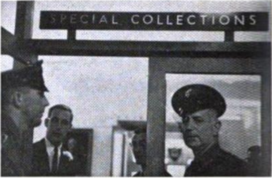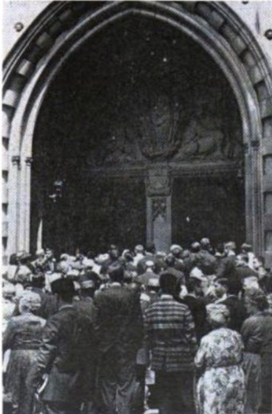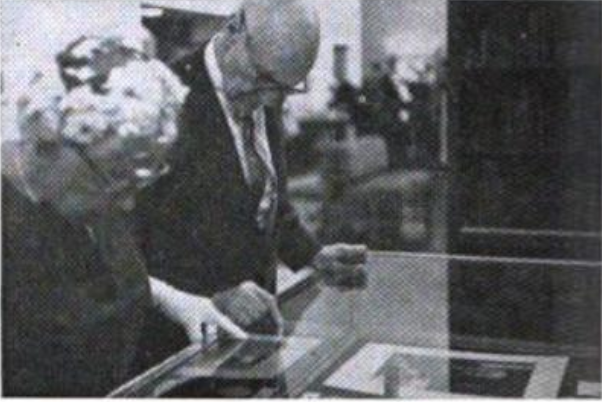Dedicating the John Foster Dulles ’08 Library of Diplomatic History

The culmination of the dedication ceremonies for the Dulles Library May 15th was former President Eisenhower’s most effective address before the largest crowd the University chapel has held since its dedication a third of a century ago. He said he would not “eulogize a man who needs no eulogy” but rather chose to talk to his “fellow Americans” informally, without notes or hesitation, about his close association with the late Secretary of State, closer than anyone’s except the immediate Dulles family. “Within six months, starting in 1953, there developed between Foster Dulles and me a trust, a common faith, that was never for a second broken. We soon began to work in a most informal manner. There were notes and telephone calls, but mostly we
had conversation. Every day in the late afternoon, about 5:30, he came over to my office, and we talked.” “After the affairs of the world had been discussed, we would throw the papers aside and begin conversations – rather philosophical and inquiring. He loved to speculate on the future of representative government.” Sometimes he spoke of his fear of pressure groups, of too many divisive influences on Congress; but “his rock-like faith in his God and his country” gave his assurance. Because of his unstinting devotion to the free world and his faith in international morality, “every single member of this audience, and all of the United States, are in his debt. To his character, insight and courage I owe a terrific debt. This is a better world because of him.” Such are some random quotes from this appealing, extemporaneous 15-minute talk.

The present Secretary of State, Dean Rusk, was at the last minute held in Washington by the Laotian crisis but phones in a statement which President Goheen read, concluding: “but out of the papers stored here in Princeton will come to a picture of a dedicated man, deeply committed to the peace and well-being of his own country and deeply, as well, aware that the fate of his own country was linked to that of peoples in the remotest parts of the world. It was a privilege to serve with him as friend and colleague and to share both his satisfactions and his disappointments as he tried to shape the course of events to accord with the aspirations of the American people and his own commitments to peace and freedom.”
Another speaker was Arthur H. Dean, United States delegate to the Geneva Disarmament Conference and a law partner of the former Secretary of State, who recalled that “Foster Dulles went to Princeton for an education and he got it.” “I recall his enthusiasm when the idea of the library was discussed. All his life he cherished Princeton.”

Dr. Henry P. Van Dusen ’19, president of Union Theological Seminary, discussed Dulles as a leading Protestant layman: “this enigmatic man was before a lawyer and a statesman, a churchman.” As a boy he attended four church services every Sunday – “at base a profoundly religious man, a man of righteous and dynamic faith.”
President Goheen led off by calling the new Library not just “a monument but a living and working instrument in the process of scholarship,” and described how President Dodds had first presented the idea to Mr. Dulles of leaving his papers to Princeton, and how the drawings had been rushed to his bedside and “enthusiastically” approved a few days before his death in 1959.
The building had its inception when a group of Mr. Dulles’ friends proposed to Princeton that they assure the cost of a wing to the Firestone Memorial Library which would stand as a memorial in tribute to Secretary Dulles and provide for the housing and use of his papers and related materials. The original group included Arthur H. Dean, Clarence Dillon, Amory Houghton, Andrew Meyer, George Murnane, John D. Rockefeller III ’29, and John Hay Whitney. Subsequently these sponsors were joined by more than three hundred other friends, associates, and relatives of the Secretary.
Dulles Library, a new wing of Firestone Memorial Library, represents a notable addition to Princeton’s facilities for the preservation and use of rare books and manuscripts. It will house not only the Dulles papers but other large manuscript collections. When President Goheen announced the establishment of the library and Mr. Dulles’ gift in May, 1959, the University and the Department of State simultaneously disclosed an agreement whereby a collection of copies of official documents of the Department of State relating to Mr. Dulles’ tenure as Secretary would be available in Princeton. This collection, consisting of microfilmed copies of original documents in the Department of State, presents an accurate picture of the field of foreign affairs during Mr. Dulles’ six years as Secretary of State. In giving his personal papers as a research collection for the study of American diplomatic and political institutions, Secretary Dulles spelled out the conditions under which scholars receive access to the collection. These conditions reflect his wish that: “Access to my personal papers, for the purposes of furthering bonafide research in the fields of history, political science, international relations and related subjects, shall be granted as widely as possible. The presumption shall be that access should be granted in any particular instance unless compelling reasons exist to withhold such access.”
Scholars seeking access to Mr. Dulles’ personal papers must receive through the University Library the written approval of a committee appointed by the Late Secretary before his death.
The Actual Building

The Dulles Library is a two-story hexagonal unit, so constructed as to permit interior and exterior identification as a separate unit while allowing full integration with the University’s other library services. It was designed by the New York architectural firm of O’Connor and Kilham and built by Matthews Construction Company of Princeton. It opens off the Special Collections area at the southeast corner of Firestone Library and blends functionally with the latter building, completed in 1948. Scholars using it will enter through the Rare Books and Manuscripts Room on the main floor. Three individual studies are especially designed for work with large manuscript collections, in addition to a reading room with basic reference books which contains a portrait of Secretary Dulles. A bibliographic area is located on this floor where the essential card catalogues and other bibliographic tools may be consulted conveniently. The level below, connecting with Firestone Library’s rare book and manuscript storage area, is equipped for the storage of extensive manuscript collections, including a special security section for classified Dulles material. “It seems appropriate that this unique collection, described by President Goheen ‘as one of the most meaningful gifts the Princeton Library has ever received,’ should be preserved in this manner,” Dr. William S. Dix, University Librarian, stated.
As a unit of the University Library it is near the editorial and research offices occupied by Dr. Julian P. Boyd and his staff, who are editing The Papers of Thomas Jefferson, a massive 52-volume project which has made Princeton a center for the study of the country’s first Secretary of State. Also nearby are the offices for the editing of the Woodrow Wilson Papers, a 40-volume project under the direction of Professor Arthur S. Link. Princeton University Press is publishing both series.

In addition to materials pertaining to Mr. Dulles’ early life and his years as Secretary of State, essential to a scholarly study of his career, the collection contains valuable records relating to the Hague Peace Conference of 1907, the World War I Peace Treaties, the creation of the United Nations, and the meetings of the Council of Foreign Ministers in London, Paris, and Moscow in the years immediately following World War II.
This collection joins other rich collections of manuscripts in the University Library for the study of American history, such as the papers of James Forrestal ’15, first Secretary of Defense, including the famous “Forrestal Diaries,” and those of Senator H. Alexander Smith ’01, fourteen years a member of the Foreign Relations Committee.
The Library’s collection of manuscripts relating to Woodrow Wilson ’79, is second in importance only to his official files in the Library of Congress. He was President of Princeton and Professor of Politics during Mr. Dulles’ student days.
The papers of Samuel L. Southard ’04, Secretary of the Navy under Presidents James Monroe and John Quincy Adams, consist of 25,000 recently discovered documents acquired by the University through the generosity of Albert Southard Wright ’00; P.H.B. Frelinghuysen ’04; Carl Otto v. Kienbusch ’06, and Sterling Morton ’06.
Letters of every President from Washington to Truman, collected for significant content as well as autograph value, are included in the collection of American historical manuscripts bequeathed to Princeton by the late André deCoppet ’15. Here, for example, are 170 manuscripts of George Washington, 125 of Thomas Jefferson, and 150 of Abraham Lincoln, as well as those of many other men in public life.
Exhibitions in the Main Gallery and the Princetoniana Room of the University Library arranged by Howard Crosby Rice Jr., Chief, Department of Rare Books and Special Collections, in connection with the Dulles Library ceremony of dedication include items from various collections and will remain on display until after Commencement.
A native of Watertown, N.Y., where he attended the Watertown High School, Mr. Dulles was the youngest and “top man” in his class on graduation in 1908 as valedictorian, recipient of the Chancellor Green Fellowship in Mental Science, and special honors in philosophy. In 1946 he was awarded an honorary LL.D. degree. The exhibit in the Princetoniana Room will recall those undergraduate years through photographs of his classmates, members of the faculty, and through campus scenes, publications, his diploma and other memorabilia.
The exhibition in the Main Gallery, entitled “United States Diplomatic History: Selected Documents from Princeton Collections,” consists chiefly of original letters beginning with Benjamin Franklin, and emphasizing the role of Princeton graduates in the foreign service.

Included are letters by: Thomas Jefferson, first Secretary of State under the Constitution; James Madison ’71, Secretary of State for eight years under Jefferson before being elected to the Presidency; Robert Smith ’81, Secretary of State under Madison; Edward Livingston ’71, Secretary of State for two years under Andrew Jackson; John Forsyth, also Secretary of State under Jackson and President Martin Van Buren, 1834-41; Richard Rush ’97, Minister to Great Britain and Acting Secretary of State, 1817; William L. Dayton ’25, Minister to France, and by Secretary Dulles. Papers form the Woodrow Wilson collection also are being shown.
This was originally published in the May 23, 1962 issue of PAW.
















No responses yet